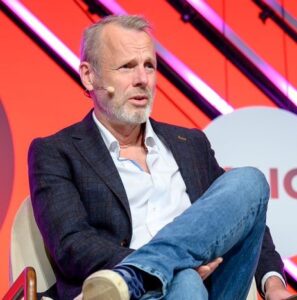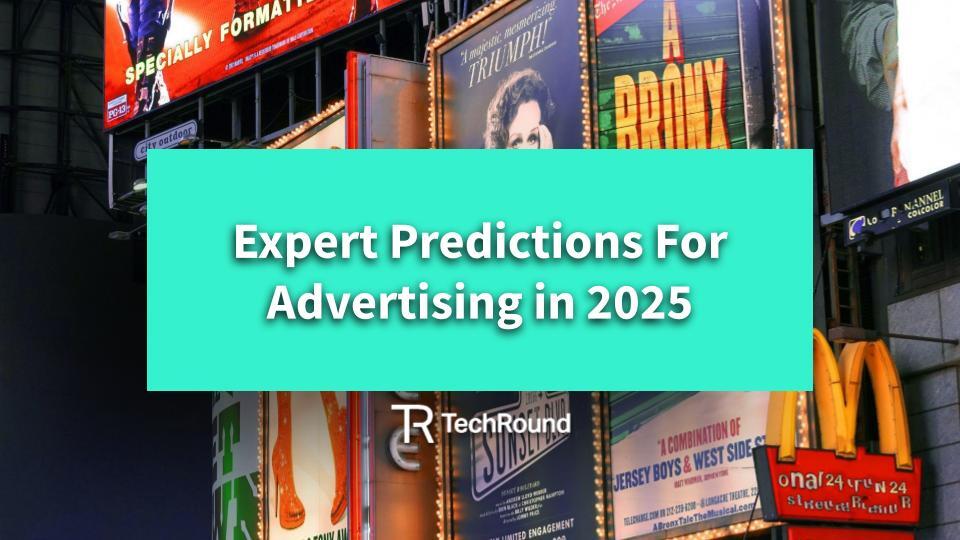Global advertising is well on its way to being worth $1.04 trillion in revenue by the close of this year, according to GroupM. Digital platforms are the main reasons for this growth, taking up over 80% of ad spending through channels like social media, retail media, search, and streaming TV.
Tech giants like Google, Amazon and Apple are expected to earn 41% of all global ad revenue. When adding ByteDance and Alibaba, this small group will control more than half of the market. Much of their success comes from smaller businesses using their platforms to run ads efficiently.
Streaming TV’s revenue is projected to grow by nearly 20% by 2025. Advertisers are putting more resources into reaching audiences who are turning to digital platforms over traditional media.
What’s Driving Digital Advertising Growth in the UK?
Here in the UK, the advertising market is predicted to grow by more than 8%, reaching $53.2 billion. Digital formats obviously take the lead, accounting for over 80% of the total. This would make the UK Europe’s largest advertising market and third globally after the US and China.
Retail media is leading the way, projected to bring in £4.7 billion next year— more than traditional TV advertising. Out-of-home ads are also making a comeback, with digital billboards and screens driving growth. Audio ads, like those on podcasts and music platforms, are holding strong too.
Streaming TV is another big winner, making up 30% of the UK’s TV advertising revenue. Major events like the Olympics and Euros are pulling in big budgets from advertisers who want to connect with wide audiences.
What Could Affect Advertising in 2025?
Global trade policies could play a big role in shaping advertising trends next year. Changes in US tariffs, for example, might affect industries like automotive and technology, which are major ad spenders.
China’s consumer market is another question mark. Spending there has been slower to recover, which could delay investments from advertisers. If conditions improve, brands might refocus their budgets on China, potentially reducing spending elsewhere.
Artificial intelligence is also becoming a bigger factor in advertising. As businesses push their AI-related products, they’re likely to adopt new ways to connect with customers, which could shake up the industry.
Our Experts:
- Daniel Landsman, Global Director of Ad Tech Solutions, Aerospike
- Maor Sadra, CEO, INCRMNTAL
- Cory Munchbach, CEO, BlueConic
- Rhiannon Lewis, Head of Production, GATE+
- Darryl Newton, Managing Director, Wooshii
- Dara Nasr, VP, WeTransfer Advertising
- Andy Duke, Group Director, Creative & Experience Design, KINESSO UK&I
- Franziska Motta Ferraz, VP, Media Owner Development, EMEA, Criteo
- Lee Metters, Senior Client Partner, Brand Partnerships and Retail Media, Awin
- Justin Reid, Senior Director of Global Partnerships Solutions, Tripadvisor
- James Hill, Chief Commercial Officer, EXTE
- Mateusz Rumiński, VP of Product, PrimeAudience
- Ryan Afshar, Head of Publishers and Programmatic Platforms, International, LG Ad Solutions
- Hugh Stevens, UK MD, LiveRamp
- Jaysen Gillespie, Head of Analytics & Data Science, RTB House
- Louise Kloster, SVP Marketing, Adform
- Richard Davis, CEO and Co-founder, 51ToCarbonZero
Daniel Landsman, Global Director of Ad Tech Solutions, Aerospike:

“In 2025, we can expect advertisers to have even more sophisticated tools for connecting with consumers at every stage of the funnel. The proliferation of personalisation powered by AI will allow brands to tailor their messages with unprecedented precision, reaching users in “moments that matter” across various channels.
“For instance, AI-driven predictive analytics will allow marketers to anticipate consumer behaviour and tailor marketing strategies in real-time. There will be an ongoing focus on breaking down data silos, ensuring that data flows freely between platforms, tools, and departments. This is critical for creating a seamless customer experience and more accurate campaign targeting.
“We’ll likely see an increase in collaboration across departments—marketing, sales, IT, and customer service—facilitated by integrated data systems. For marketers, this will mean less complexity, faster decision-making, and improved campaign performance, especially in terms of ROI. Additionally, AI will take on more roles in automating routine tasks, from content creation to optimisation, freeing marketers to focus on strategy and creative direction. This will result in a more cohesive, data-driven approach to marketing that directly ties into business outcomes.”
Maor Sadra, CEO, INCRMNTAL

The GenAI Ad Network
“There’s no question that 2025 will see the launch of programmatic networks that monetise generative AI (GenAI) to create videos on demand.
“GenAI’s ability to create content in seconds is ripe for exploitation, and an ad network powered by this technology would mean brands could inject product placements in cheap, real-time video ads that would be pumped out across channels.
“While this might raise brand awareness, there’s no guarantee it will build reputation, as these ads will be devoid of personalisation. What’s more, it’s a brand safety risk, as there’ll be little to no control over placements.
“A GenAI ad network is something big brands won’t touch with a barge pole, but smaller brands with less budget could be tempted by the idea of cheap, multi-channel video advertising.
“Rightly or wrongly, these ad networks will come into play and it’s up to individual brands if they want to risk their budgets on them.”
The evolution of MMPs
“Mobile Measurement Partners (MMPs) have had a rough ride of late. Where once, brands and publishers relied on MMPs to track users on mobile, the loss of user-level data and ever-increasing privacy regulations mean MMPs can no longer perform the functions they used to. This has been exacerbated by multichannel advertising, which means that mobile is now part of a much wider marketing mix.
“Some MMPs have ventured into measurement across other channels such as CTV, offline and desktop web but it’s not their forte and the results have been patchy at best.
“Now Big Tech is beginning to integrate alternative third-party measurement and monetisation solutions with expertise beyond mobile, MMPs are being further pushed out.
“So does that mean the industry is going to see MMPs gradually die out?
“The short answer is, no. MMPs won’t disappear but they will adapt. What we’re likely to see in 2025 and beyond is an evolution of the MMP by which they expand their remit to move into creativity and monetisation. We expect certain MMPs to incorporate creativity offerings through GenAI creative tools.
“Others are likely to make a gradual move to provide services for publishers, away from catering exclusively to the advertisers i. One of the first examples of this was AppsFlyer acquiring Oolo and we expect that there will be more acquisitions of this type in the coming years.
“By the end of the decade, MMPs (Mobile Measurement Platforms) may end up becoming MPs (Mobile Platforms) or just Platforms. A Sort of an ecosystem that offers a variety of solutions beyond measurement.”
2025: The year the industry finally stops caring about cookies
“At the start of the year, a proportion of marketers were still concerned about Google’s third-party cookie deprecation. And the tech giant’s u-turn back in July left some breathing a sigh of relief.
“That relief would’ve been short lived however. What’s become increasingly apparent in recent months is that we’re already living in a post privacy world. The majority of consumers reject cookies and match rates have plummeted.
“Therefore, whether or not Google ever kills the cookie has become irrelevant.
“Brands and publishers that haven’t been using alternative methods for tracking and targeting for the last two years, have already subjected themselves to limited addressable audiences. Soon these audiences will disappear altogether.
“As we enter 2025, no one should be relying on third-party cookies. Highly effective privacy-safe solutions for targeting and measurement are readily available. It’s time to give up the unhealthy cookie addiction and sweep those crumbs away for the last time.”
Cory Munchbach, CEO, BlueConic

The evolution of media through clean rooms
“The media industry isn’t going to die but many big publications urgently need to focus on serving their audiences first. For some, it may already be too late.
“The criticality of delivering a product the audience wants will lead to further fragmentation in media. Yet with this will come the opportunity for better premium products to enter the market that blend programmatic elements for publishers who have the scale to offer it.
“Those without the scale will turn to clean rooms, which offer an opportunity for cross-publisher data cooperatives that can be monetised with brands. We’ll see a similar trend play out as retail media networks (RMN) jockey for position and an entirely new generation of marketers shift budgets based on insights from first- and second-party data.”
Marketers stage a comeback.
“After two years of being the first on the chopping block for budget cuts and the easy target for tech team takeover, marketers get their mojo back in 2025. Companies are realising that failing to invest in marketing hurts both operational efficiencies and business performance.
“Marketers will also be back in the driving seat for technology investments that directly affect them. While integrations with cloud data warehouses will be a standard option, hybrid CDPs that support composable and a standalone packaged offering will become the norm, as buyers confront the very different use cases and needs that the business requires to drive growth, not just manage data or generate insights. The “final mile” of segmentation and activation that happens in CDPs is a critical bridge that is often undervalued when technical-only teams are making the CDP decision.”
AI goes from breathless to oxygen.
“The hyperbolic and hypothetical of AI has become a ubiquitous part of business operations, though still experimental and incremental. And for good reason. Privacy. Compliance. Governance. Things that have always been challenging and critical are exponentially more so when AI is involved.
“In 2025, marketing workflows will be transformed by AI. In turn, the way CDPs deliver value will evolve to balance the human element and the automation, the privacy and possibility, and creativity and control. These tensions aren’t new in marketing but have been magnified exponentially by AI. CDPs have a critical role to play in managing these potentially competing priorities so that marketers can harness AI in a way that supports their core jobs to be done in new and improved ways.”
Experience-driven data collection builds trust.
“Amid growing privacy concerns, consumers are more hesitant to share their data, even when it’s meant to improve their shopping and advertising experiences. The challenge for marketers is not just collecting data, but earning the trust of their audience by how it’s gathered and the experiences it fuels.
“In 2025, expect a major shift: brands will move from transactional exchanges to engaging, customer-centric experiences, using tools like quizzes, interactive polls, product finders, and lookbooks to gather insights on their terms. These approaches not only respect privacy but foster trust, enabling brands to gather valuable data without overstepping boundaries. The brands that get this right will unlock insights that fuel innovation and deliver personalised experiences.”
Rhiannon Lewis, Head of Production, GATE+

“Advertising production in 2024? Forget trends; it’s about a total system overhaul. The old layers of separation? Gone. Whether it’s a client or an agency, everyone wants to be connected to the makers—aligned, streamlined, mission-focused. It’s not just about creating content; it’s about crafting smart content: razor-sharp, wildly creative, and fast. The demand? Do more, do it better, and do it now. It’s leaner, meaner, and honestly? Kind of exhilarating.”
Darryl Newton, Managing Director, Wooshii

“Podcasts feel like they’ve been growing for years, but the adoption (and engagement) from harder to reach audiences, and the simplistic way of buying the medium, presents a growing opportunity for the market in 2025. Not only can they win elections (apparently), but podcasts listeners are also rising at a faster rate in younger and senior markets than any other medium – even YouTube is providing free AI tech to convert video into podcasts.
“Bold, disruptive creative strategies will dominate social media advertising in 2025. Brands will increasingly abandon traditional consistency, experimenting with platform-specific personas and prioritising entertainment over conventional advertising. This shift toward creative risk-taking will drive the need for more advanced measurement tools. Companies will need more sophisticated metrics to evaluate creative itself and to understand both the immediate engagement and long-term brand impact across a far more diverse creative.”
More from News
- How Is Google Dealing With Fraud In India?
- What Are The Main Sources Google’s AI Overview Uses?
- New Drone Flights Approved to Help Monitor Railways
- How The UK Government Is Helping With Employment Reform
- What Are The Data-Related Risks Of Period Tracker Apps?
- Investment in UK Businesses Up 3% This Year
- How Much Water Does ChatGPT Actually Use?
- Why Is Tesla Facing Legal Action In Australia?
Dara Nasr, VP, WeTransfer Advertising

1.A rise in confidence across the advertising industry
“2024 was the year of the election with at least 70 happening worldwide, including in major advertising markets like the US, UK and France. With any election, the unpredictability associated with it limits free range advertising – uncertainty is generally awful for advertising. For 2025, I foresee more swagger and confidence in the industry with there, hopefully, being less political volatility. Advertisers will be able to be more bold with what campaigns they put out there and not be restricted by the sensitivities of an election timeframe.
2.The changing role of the CMO and the impact it has on storytelling
“Over the last few years we have seen the average tenure of the CMO decrease, with it becoming more of a revolving-door position. The short term life expectancy of the CMO has meant the long term perspective needed for storytelling and risk taking has become less of a priority. As a result, storytelling is not what it used to be and brand building has suffered. I’d really love to see 2025 be the year that this changes. Critically, CMOs need the full support of businesses to encourage them to take more risks and not just go for the safe, yet boring, option in order to keep their job.
3.Attention, Attention, Attention
“Attention has gone from being a niche measurement metric to one that is on every advertiser’s lips and a key part of media measurement. Next year we will see this continue, uniting brand and performance driven ads by forcing us all to think about how we can best capture a specific audience’s attention. Gone are the days where a beautifully delivered advert can exist without being designed for maximum attention. By providing deeper insights that go beyond the traditional metrics, attention is a strong predictor of effectiveness. The strong correlation between attention and business outcomes is no coincidence – never before have we had such accuracy to indicate the effectiveness or impact of an advert.
4.The importance of effective engagement
“As we approach 2025, the key to effective digital advertising isn’t just about visibility; it’s about effective engagement. When an attentive, highly engaged audience intersects with a big idea, that’s where the magic happens—where brands can create lasting impact. It’s time for brands and media agencies to take a bolder approach to diversifying their media mix and rethink not just the way they tell stories, but where. While brand building is alive and well across digital platforms, meaningful storytelling requires more than capturing 1-2 seconds of attention.
5.‘Emotioneering’ and creativity
“Let’s face it, relying on the same old digital media playbook doesn’t cut it anymore. As we’re approaching 2025, the key to effective brand advertising isn’t just about visibility; it’s engagement that matters. To truly captivate audiences, brands need to think beyond the usual suspects and embrace a richer, more diverse media mix. It’s less about “scroll and forget” and more “pause and remember”- creativity deserves attention. Steering this creativity with insights like video ads typically see +30% attention than non-video ads, is a real game changer. The agencies and brands that go against the grain and don’t follow predictable strategies, are the ones who make impressions count and deliver successful campaigns that actually resonate with audiences.
“The magic happens when big ideas meet attentive audiences, whether that be total surprise, or a laugh out loud moment. Emotional resonance isn’t fluff; it’s what sticks in people’s minds and drives action. But if you’re banking on platforms that only hold attention for a second, you’re selling your creativity short.”
Andy Duke, Group Director, Creative & Experience Design, KINESSO UK&I

1.Generative AI as a Creative Partner
“Generative AI tools like ChatGPT and DALL-E will finally move on from being shiny new toys and become integral in content creation. Adobe’s recent study reveals 83% of creatives already use AI in some capacity. That figure is only going to continue to grow, AI will finally start to streamline idea generation and production in a useful way, allowing creatives to focus on storytelling. Brands should invest in AI tools and training to automate repetitive tasks and amplify ideation. This frees up resources for crafting more compelling creative at scale without sacrificing on quality or cost.
2.The Exciting Beginnings of ‘Multisensory Content’
“Advancements in haptic technology and all kinds of other immersive sensory experiences might begin to drive the creation of new types of content that engages multiple senses. Research indicates that integrating multiple sensory cues can massively enhance brand recall and increase customer engagement so it could be a super exciting new area.
What does this mean for brands? Brands should think about exploring multisensory storytelling to deepen emotional connections with their audience. Anything from incorporating tactile feedback in digital advertisements or developing distinctive audio branding that can create memorable customer experiences could become possible.
3. Short-Form Video Dominance
“Platforms like TikTok and Instagram Reels continue to prioritise short-form video. HubSpot reports 90% of marketers find video crucial to their strategies, with short form driving the highest engagement rates. What does this mean for brands? Brands need to focus on creating concise, visually engaging, and authentic videos that resonate quickly. This means fewer polished ads and more relatable, story-driven clips.”
Franziska Motta Ferraz, VP, Media Owner Development, EMEA, Criteo

“The continued rise of Retail Media and Commerce Media is reshaping the digital advertising landscape. Brands, retailers, and publishers are increasingly capitalising on these opportunities, evolving their strategies to meet changing market demands.
“In 2025, programmatic advertising will play a pivotal role in unlocking the potential of commerce media. By leveraging automation, data-driven insights, and real-time decision-making, programmatic will empower advertisers to connect with consumers more effectively and drive growth.
“As consumer expectations lean heavily towards convenience, 2025 will likely see a surge in shoppable ad formats and commerce content. These formats and commerce will enable consumers to become closer to the point of purchase, minimising friction in the shopping journey.
“Moreover, commerce media networks will further integrate advertising into retail environments – both onsite and offsite – blurring the lines between discovery and purchase. This seamless shopping experience is the hallmark of commerce everywhere, where every ad is a gateway to a transaction, and every interaction is an opportunity to convert.”
Lee Metters, Senior Client Partner, Brand Partnerships and Retail Media, Awin

“2025 will be the year non-endemic retail media opportunities truly take off. Retail media’s remarkable growth continues unabated, driven by evolving consumer behaviour and shifting market dynamics. As established retail media networks approach saturation within their current ecosystems, the industry is at a turning point.
“Non-endemic retail media offers a way forward, enabling brands to expand their reach by tapping into new or untapped audiences. These unconventional yet complementary partnerships will not only boost advertising impact but also provide invaluable first-party data – an increasingly critical asset in a privacy-conscious, data-driven landscape. Now is the time for brands to rethink their strategies and embrace the potential of non-endemic partnerships to stay ahead of the competition.”
Justin Reid, Senior Director of Global Partnerships Solutions, Tripadvisor

“In 2025, brands need to be innovative, focusing on understanding their audiences and tailoring campaigns to niche interests such as sports, pets, or fashion to create authentic, engaging experiences for all.
“Doing this successfully will allow for strategies that go beyond targeting one-off moments. As consumer spending becomes more fluid and strategic, brands must consider the impact of long-term behaviours, such as planning for significant large purchases or travel experiences. Campaigns that align with these broader priorities will remain relevant and impactful over time, extending a brand’s reach and resonance.
“To achieve this, brands will turn to a mix of endemic and non-endemic platforms, using these diverse channels to connect with consumers in new and innovative ways. Successful brands will integrate data-driven insights with creative storytelling, ensuring their campaigns are strategic and memorable.”
James Hill, Chief Commercial Officer, EXTE

“In 2025, AI will continue to transform content marketing, enabling hyper-personalisation while protecting consumer privacy. Moreover, creativity will remain a key differentiator in a crowded market, with AI helping to drive innovation and allow brands to offer unique and personalised experiences that stand out.
“By leveraging AI-driven insights, brands can craft tailored campaigns that resonate deeply with their audiences. To enhance this, contextual tools will be crucial for aligning content with evolving consumer behaviours, creating more meaningful interactions and relevancy. Furthermore, leveraging innovative ad formats with Connected TV (CTV), shoppable ads, and interactive video experiences will emerge as powerful tools for engaging consumers. These formats cater to the growing demand for immersive content, allowing brands to deliver captivating storytelling and facilitate seamless interactions within the consumer journey.”
“Focusing on these advancements will allow brands to build stronger connections and engage consumers more effectively in 2025 and beyond.”
Mateusz Rumiński, VP of Product, PrimeAudience

“As we look towards 2025, the impact of Generative AI only grow. We’ve already discussed some theoretical possibilities, and some practical tools have since emerged. Now it’s the time to increase the number of options available and, more importantly, scale the technology. Marketers are already aware of this, with recent PrimeAudience data revealing that 49% of UK and US marketers plan to increase the marketing budget spent on Gen AI in 2025 by at least 16%.
“There are an increasing number of powerful models available at lower price points. This development has transformed content creation, hyper-personalisation and campaign efficiency, empowering brands to deliver highly targeted experiences to individual consumers. If used effectively, these multimodal systems can streamline workflows and give smaller brands access to tools previously only available to much larger players.
“What is most exciting about this technology is its collaborative properties. AI has been designed to work alongside humans, enhancing the decision-making process in the long run for the entire advertising ecosystem. Those who adapt quickly will remain ahead of the game and set new standards for consumer engagement and brand experience.”
Ryan Afshar, Head of Publishers and Programmatic Platforms, International, LG Ad Solutions

“Smaller and more medium-sized businesses will increasingly shift ad budgets from social, digital, and search channels to CTV, recognising it as a more impactful way to reach broader and more engaged audiences. This trend reflects CTV’s unique combination of visibility, high attention, and emotional resonance, allowing SMEs to create memorable brand moments on the “biggest screen in the house.”
“CTV’s measurable, engaging environment will appeal to marketers seeking a powerful, TV-based presence. Every Marketing Director, no matter the size of the company, wants to see their ad on TV, and now they can.”
Hugh Stevens, UK MD, LiveRamp

“With inflation expected to persist into 2025, marketing budgets will likely stay lean while demand for performance metrics and attribution will continue to rise. Accurate, transparent and omnichannel measurement that delivers actionable insights will be vital to optimising media spend. As a result, we will see a continued shift in spending toward both retail media and commerce media environments.
“Indeed, as advertisers increasingly leverage first-party data to mitigate signal uncertainty, the unique insights available within commerce media will likely close the gap between these networks and retail media. With high-quality datasets like consumer behavioural insights, key customer groups, and trending interests, these can provide a deeper understanding of target audiences and are highly valued by advertisers. While retail media currently holds the edge for scale and reach, increased usage of data collaboration and tools like clean rooms will enhance connectivity and propel commerce media as the go-to partner for advertisers.”
Jaysen Gillespie, Head of Analytics & Data Science, RTB House

“The demise of third-party cookies in Chrome has been on the horizon for years, so it should be no surprise that Google has provided users with more choice. Predictions suggest that 60-80% of users will turn off third-party cookies, influenced by their interest levels in privacy and Google’s cookie dialogue.
“This era of ineffective and unreliable third-party data means that in its place, next-generation AI technologies will drive a resurgence of contextual, page-based targeting. With its ability to make high-quality decisions at scale, AI will redefine precision in digital marketing, ensuring brands thrive despite the industry’s unknowns.
“Once the cookie tidal wave crashes, the “audience buying” model as we know it will be swept away. The focus will shift to building something stronger with first-party data, where audiences will become increasingly valuable. By identifying customers and retargeting ads, particularly through Deep Learning technology, brands can drive conversions, acquire new customers and enhance cross-selling opportunities from related sites.”
Louise Kloster, SVP Marketing, Adform

“If 2024 has been about the decline if not quite the death of the third-party cookie, then next year will see its value for advertisers disappear completely. With Google likely to install a consent-based model, research has projected that almost 90% of US browsers will become cookieless.
“There is no single, silver bullet solution waiting in the wings to replace it, and, considering the trouble the Privacy Sandbox has experienced, holding out hopes for one to materialise is unrealistic. Instead, we currently observe hundreds of rich and diverse identity alternatives in play, and we already experience advertisers’ appetite to leverage the full benefits of this new multi-ID world. DSPs who employ a rich combination of first-party IDs and alternative solutions will succeed while those that are ID-limited will fail media buyers. Advertisers meanwhile will reap the game-changing benefits of streamlined omnichannel performance and measurement, securing optimised reach with reduced ad waste.”
Richard Davis, CEO and Co-founder, 51ToCarbonZero

“The ad industry’s contribution to the climate crisis cannot be ignored. With multiple reports showing the major environmental impact of advertising, brands, agencies and vendors are being forced to act. But advertising can be part of the solution.
“In 2025, we expect there to be an industry-wide trend that goes beyond simply carbon measurement to actually making progress towards net zero. To date, there’s been too many token gestures but not enough progress has been made. Big tech companies have in fact increased their emissions by 30-50% in the last few years.
“Businesses that want to make a difference will have to go beyond the minimum measuring, reporting and complying. And with large advertisers now feeling the pressure to deliver on their 2030 net-zero targets and major industry support for Ad Net Zero, players across the advertising ecosystem are finally beginning to take meaningful action.
“People are tired of promises. Ad Net Zero was established in 2020 with the aim of decarbonising the business operations of all advertising players, including the production, distribution, and publication of advertising by 2030. 2025 therefore marks an important milestone in progress and needs to represent a significant turning point if we’re to reach net zero in the next five years.”
ᐧ



